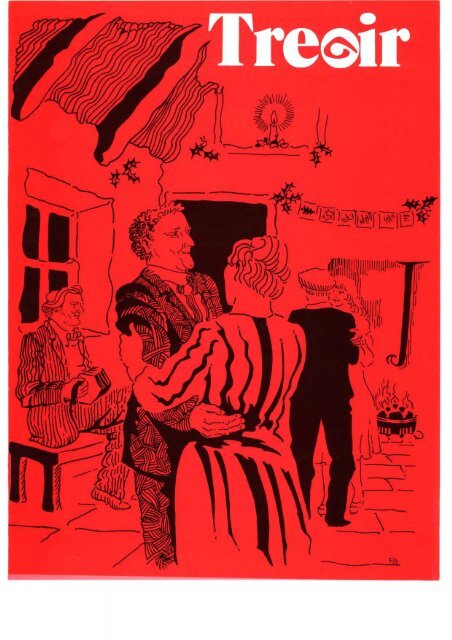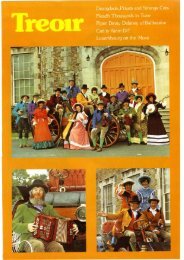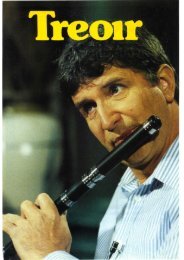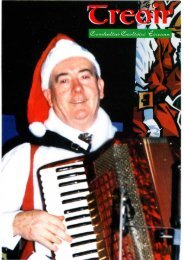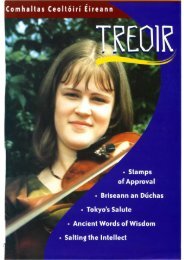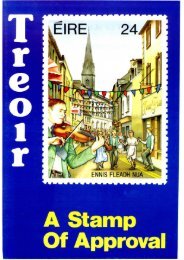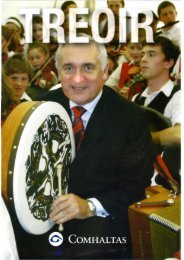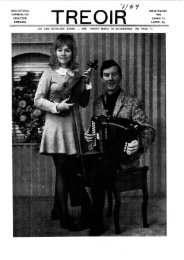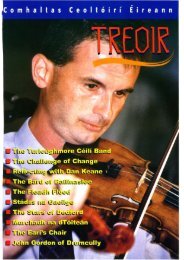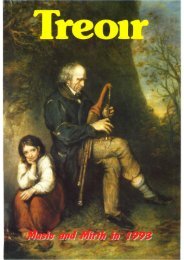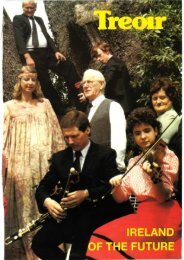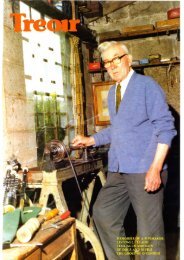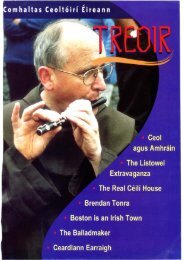You also want an ePaper? Increase the reach of your titles
YUMPU automatically turns print PDFs into web optimized ePapers that Google loves.
door I could hear them playing a selection<br />
of tunes together. Then suddenly, a<br />
flute solo, "The Garden of Daisies" and I<br />
recognised the player immediately and I<br />
thought of a little girl with plaits and a<br />
bony fifteen-year-old in socks.<br />
The musicians crowded into my ward<br />
and suddenly my heart turned over. She<br />
stood out from them like ,a burning<br />
flame , a glowing Christmas candle -<br />
that coppery hair now gleaming shoulderlength;<br />
her eyes closed as she concentrated<br />
on her playing; long copper lashes<br />
brushing a faint sprinkling of freckles<br />
left over from the summer sun . Then they<br />
finished and she opened her eyes and saw<br />
me. "Johnny" she called and was over<br />
like a flash, sitting on my bed, laughing,<br />
talking, drawing all the group into our<br />
conversation, but I could see only her,<br />
the little girl in the meadow, the awkward<br />
fifteen-year-old, now a beautiful radiant<br />
doe Cooley Memorial Hall<br />
J oe Cooley, the well known accordeon<br />
player from Peterswell, Co. Galway, is<br />
almost five years dead. Joe's death, at<br />
forty nine , has deprived Ireland of one of<br />
her greatest and best loved traditional<br />
musicians.<br />
No more will he play his very special<br />
and unique style of traditional Irish music<br />
in the homes, concert halls and pubs of<br />
Ireland, Britain and The United States of<br />
America- that very special style of Irish<br />
music which stirs one's very soul, which<br />
elevates one's spirit.<br />
'Though five years have gone since<br />
Joe's passing, his name and his music are<br />
still fresh and green in the minds and<br />
hearts of the people who knew and loved<br />
him; in the minds and hearts of the<br />
people who never knew Joe Cooley personally<br />
but who've listened to and relished<br />
his music on the one and only L.P.<br />
that he ever made.<br />
So much of a love and an appreciation<br />
and, indeed, sometimes adoration has<br />
grown around Joe Cooley, the musician<br />
and the man, that many people at home<br />
in Ireland and across the Irish sea have,<br />
many times, expressed the wish that the<br />
memory of J oe Cooley should be perpetuated<br />
in a fitting and constructive way.<br />
This great love of Cooley has grown so<br />
much that visitng Americans from Texas<br />
to Chicago, from New York right across<br />
to San Francisco visit Joe's grave when on<br />
vacation in Ireland. Indeed the footsteps<br />
of Australians have helped to tramp a<br />
path in the grass to Cooley's last resting<br />
place.<br />
In J oe Cooley's native village of Peterswell<br />
is an old school-house- built in 1847<br />
and closed in 1944. 'Twas here that he<br />
and his brothers and sisters received their<br />
Primary Education. One eveing in the<br />
Autumn of 1973 and sadly in the Winter<br />
of Joe's life, he stood with his sister,<br />
Agnes, (Mrs. Carew) in front of the old<br />
school, and said to her: " If i live another<br />
year or two Agnes, I will play my heart<br />
out and collect enough money to build a<br />
Community Hall for the young and old<br />
on the site of that old school. Wouldn't<br />
it be grand to see the children enjoying<br />
themselves and an Irish tune being played<br />
in a new hall". Alas, Joe was dead within<br />
two or three months and his lifetime wish<br />
unfulfilled.<br />
Last year a fund raising committee<br />
was formed to finance the building of a<br />
Joe Cooley Memorial Hall ; a community<br />
hall and Irish cultural centre which will<br />
benefit young and old; a hall which will<br />
be a fitting tribute to one of Ireland's<br />
greatest sons. But money is urgently<br />
needed to build this memorial hall. In<br />
Loughrea and Gort, ceilis have been held<br />
to raise finance. The Edenderry branch of<br />
<strong>Comhaltas</strong> Ceoltoiri Eireann (Co. Offaly)<br />
of which Joe's brother, Tom, is a member<br />
were guest artistes at a fund-raising<br />
function in Loughrea, Co. Galway.<br />
The Joe Cooley Memorial Hall committee<br />
asks every branch of <strong>Comhaltas</strong><br />
Ceoltoiri Eireann- in Ireland and all over<br />
the world-to hold an Irish Night to help<br />
finance the building of the hall. The committee<br />
also appeals to the lovers and admirers<br />
of Joe Cooley's music to respond<br />
generously to this request for financial<br />
aid. All subscriptions should be sent to:<br />
'Joe Cooley Memorial Hall Fund,<br />
Peterswell, Co. Galway , Ireland.<br />
girl 0 f twen ty .<br />
That was last Christmas. Now {t's<br />
Christmas week 1978. Our <strong>Comhaltas</strong><br />
group will be playing this morning<br />
down in the Parish Church. But today<br />
neither Noreen's flute nor my fiddle<br />
will be part of the group. They'll have<br />
to do without us. Because I'll be waiting<br />
at the altar-rails and Noreen will be<br />
coming towards me on her father's arm.<br />
Cludaigh<br />
Front cover: Drawing by the young Dublin<br />
artist FRANCES BOLAND.<br />
Back inside cover: KIERAN LYNCH, Ballincollig,<br />
winner of four All-Ireland<br />
awards at Fleadh Cheoil na hEireann '78.<br />
He got first in Singing (English) and Uillean<br />
Pipes (Slow Airs) ; and second in accordeon<br />
and Uilleann Pipes (open). In addition<br />
he received the Carling Trophy for<br />
the best all -round competitor in Munster,<br />
having qualified in seven competitionsmusic<br />
and singing.<br />
Back outside cover: A young harpist<br />
photographed at the Fleadh Cheoil in<br />
Listowel.<br />
7
passed by the music of Gennany, by the<br />
music of Italy, or the music of England.<br />
Gennany for purity of style, for depth of<br />
expression, for the agrument of song, surpasses<br />
all the nations to-day. Italy is acknowledged<br />
to be the queen of that lighter,<br />
more pleasing, more sparkling, and, to<br />
me, more pleasant style of music .<br />
In her own style of music England is<br />
supposed to be superior to Italy, and,<br />
perhaps, equal to Gennany. But, great as<br />
are the musical attainments o( these great<br />
peoples, there is not one of Hiese nations,<br />
or any other nation, that can point back<br />
to such national melody, to such a body<br />
of national music as the Irish.<br />
Remember that I am not speaking now<br />
of the laboured composition of some<br />
great master; I am not speaking now of a<br />
wonderful mass, written by one man·; or a<br />
great oratorio, written by another- works<br />
that appeal to the ear refined and attuned<br />
by education; works that delight the critic.<br />
I am speaking of the song that lives in<br />
the hearts and voices of all the people ; I<br />
am speaking of the national songs you<br />
will hear from the husbandman, in the<br />
field, following the plough; from the old<br />
woman, singing to the infant on her knee ;<br />
from the milkmaid, coming from the<br />
milking; from the shoemaker at his work,<br />
or the blacksmith at the forge, where he<br />
is shoeing the horse. This is the true song<br />
of the nation; this is the true national<br />
melody, that is handed down, in a kind of<br />
traditional way, from the remotest ages ;<br />
until in the more civilized and cultivated<br />
time, it is interpreted into written music ;<br />
and then the world discovers, for the first<br />
time, a most beautiful melody in the music<br />
that has been munnured in the glens<br />
and mountain valleys of the country for<br />
hundreds and thousands of years.<br />
Italy has no such song. Great as the<br />
Italians are as masters, they have no popularly<br />
received tradition of music . The<br />
Italian peasant (I have lived amongst<br />
them for years) while working the vineyard,<br />
has no music except two or three<br />
high notes of a most melancholy charactter,<br />
commencing upon a high dominant<br />
and ending in a semitone. The peasants of<br />
Tuscany and of Campagna, when, after<br />
their day's work, they meet in the summer's<br />
evenings to have a dance, have no<br />
music ; only a girl takes a tambourine and<br />
beats upon it, making time, and they<br />
dance to that, but they have no music.<br />
But go to Ireland; listen to the old<br />
woman as she rocks herself in her chair,<br />
and pulls down the hank of flax for the<br />
spinning; listen to the girl coming home<br />
from the field with the can of milk on her<br />
head; and what do you hear?-the most<br />
magnificent melody of music. Go to the<br />
country merry-makings and you'll be sure<br />
to find the old fiddler, or old white-headed<br />
piper, an infinite source of the brightest<br />
and most sparkling music.<br />
How are we to account for this: We<br />
must seek the cause of it in the remotest<br />
history. It is a historical fact that the maritime<br />
or sea-coast people of the north and<br />
west of Europe were, from time immemorial,<br />
addicted to song. We know, for instance,<br />
that in the remotest ages the kings<br />
of our sea-girt island, when they went<br />
forth upon their warlike forays, were always<br />
accompanied by their harper, or<br />
minstrel, who animated them to deeds of<br />
heroic braver.<br />
Celli at . Liverpool<br />
Irish Centre<br />
Once again the whole of the Northern<br />
Region have met for their annual Ceili,<br />
this time in Liverpool, the last two years<br />
it has been held in Manchester. It has<br />
often been said that the family who prays<br />
together stays together and I like to think<br />
the same could be applied to <strong>Comhaltas</strong>.<br />
Once a year we meet together; people<br />
from all the branches in the North. It is<br />
comforting to see everyone gathered<br />
under one roof. All the old familiar faces,<br />
some new ones and people who have<br />
travelled from miles around for a night<br />
together.<br />
The Irish Centre is an ideal venue , well<br />
worth a visit not only for the music and<br />
dancing. The whole structure is worthy of<br />
more than a second glance. The ceilings<br />
are most unusually ornate and it would<br />
take some time to study the mouldings<br />
and carved figurines. The freize where<br />
panelled walls meet the high ceiling is<br />
adorned with white dancers on a wedgewood<br />
blue background. Above the large<br />
stage a series of coats of anns from the<br />
provinces intermingle with gold laquered<br />
St. Bridget's crosses and the Tricolour<br />
flies in all it's glory. Paintings of<br />
Connemara and Donegal grace the walls.<br />
Showcases highlight the beauties of<br />
Waterford crystal. The shop is resplendent<br />
with all that is good in Irish craftmanship<br />
and traditional music records<br />
can be bought along with paperbacks and<br />
the old Claddagh rings. In the restaurant<br />
and tea bar, people buy Irish made cheese<br />
and sausage to take home with maybe an<br />
odd bag of flour for the coming weeks'<br />
soda bread. Newspapers from "home" are<br />
on sale in the foyer and the notice boards<br />
Even when the Danes came sweeping<br />
down in their galleys upon the Irish coast,<br />
higll on the ' prow of every war-boat sat<br />
the SCALB, or poet- white-haired, heroic,<br />
wrinkled with time- the historian of<br />
all their national prowess. And when they<br />
approached their enemy, sweeping with<br />
their long oars through the waves, he rose<br />
in the hour of battle, and poured forth<br />
his soul in song, and fired every warrior<br />
to the highest and most heroic deeds.<br />
Thus it was in Ireland, when Nial of the<br />
Nine Hostages swept upon the coast of<br />
France and took St. Patrick (then a<br />
youth) prisoner; the first sounds that<br />
greeted the captive's ears were the strains<br />
of our old Irish harper, celebrating in a<br />
language he knew not the glories and<br />
victories of heroes long departed.<br />
are fIlled to capacity advertising<br />
coming attractions. It surely is aptly<br />
named the Irish Centre.<br />
Admist the splendour of this awe<br />
inspiring building, which plays next door<br />
neigllbour to the Catholic Cathedral, lies<br />
the true fiery spirit of Liverpool's own<br />
well loved ceili band. No one could fail to<br />
note the lift they afford the music. Their<br />
musicians don't stand on ceremony. nor<br />
suffer lengthy pauses between the. dances .<br />
Their style is positive, pure traditional<br />
music, indeed for the ears. No wonder<br />
people stood in loud applause, in appreciation<br />
for the music provided for this<br />
years event. They played for a wide<br />
variety of dances, the "Sweets of May",<br />
the "Fairy Reel" and, of course, the more<br />
popular "Sixteen Hand Reel", to name<br />
but a few .<br />
It was a large yet homely gathering, a<br />
culmination of the year's events. I'm sure<br />
that all who attended this year's gathering<br />
of the branches agree that once more<br />
it proved to be the success we will always<br />
hope for.<br />
Barbara Callaghan<br />
MUSICAL<br />
INSI'RUMEN1S<br />
UILLEANN PIPES TIMBER FLUTES,<br />
and BODHRANS. Details and price list-<br />
26 , Spring Gardens, Newark, Notts, England.<br />
23
Bernie O'Connell<br />
An Rinceoir Tradisiunta<br />
Aicim ar Mhuire 's ar Iosa<br />
Go dtaga si aris chugainn slan<br />
Go mbeidh rind [ada 'gab hail timpeal/<br />
Ceol fidiZi 's tine cnamh;<br />
, On a cold and wet October afternoon,<br />
in a little graveyard, outside the village of<br />
Lixnaw, in cou'nty Kerry , Bernie 0 Connell<br />
was laid to rest. She was but eighteen<br />
years old.<br />
Her tragic death came as a great shock<br />
to all of north Kerry, and indeed other<br />
parts of Munster ,-it was her pleasant personality;<br />
her respect for people young<br />
and old and her ability to master the traditional<br />
dancing, that gave her her popularity.<br />
Bernie was a kind, gentle and lovable<br />
person, who had an interest in every<br />
aspect of Irish Culture. Though her time<br />
in this life was short, she still played an<br />
active part with the local branch of <strong>Comhaltas</strong><br />
Ceoltoiri Eireann, where she took<br />
part in many concert sessions, Feilti<br />
Cheoil, etc., and it's many is the floor on<br />
which she battered out a hornpipe, reel or<br />
a Kerry set through her involvement with<br />
the wrenboys at Christmas time.<br />
It was her good fortune to be born<br />
into a family where traditonal music,<br />
singing and dancing, were deeply appreciated.<br />
Her mother (Mrs. Hannah 0 Connell)<br />
is present Chairlady of the Lixnaw<br />
branch of <strong>Comhaltas</strong>. Bernie learned most<br />
of her dancing from Kay . Spillane of<br />
Cauesway, another great exponent of<br />
traditional dancing in the north Kerry<br />
area, and after moving to Dublin, to take<br />
up employment, she had arranged to attend<br />
the ceili dancing classes at Culturlann<br />
na h-Eireann. This in itself showed<br />
her deep interest in the art.<br />
At her funeral , hundreds of mourners<br />
came to pay their final respects to an<br />
"Irish girl". A guard of honour was given<br />
by the local branch of <strong>Comhaltas</strong> Ceoltoiri<br />
Eireann, and also by other societies.<br />
Mo chreach is mo chas 's e bas a thagann<br />
go trom,<br />
Nuair a leagtar ar lar an cara ba mhaith<br />
Zinn bheith ann.<br />
Suaimhneas Siorai da anam<br />
Eamonn 0 hArgam<br />
"Dia's Muire dhibh. Tairnid anseo ag an<br />
bhFleadh Cheoil agus ag baint an-taitnirnh<br />
ar fad as gach rud. Deirtear Iinn go mbeidh<br />
Fleadh '79 ar siul i mBuncrana. An mbeidh<br />
sibh ann? Beirnid-ne, le Cunarnh De."<br />
JOAN O'GRADY of Roscrea performed<br />
with the RSlscrea Seisiun Group and also joined<br />
the Bridge Ceili Band as pianist on Sunday<br />
night at Seisiun na Sarnhna.<br />
CAPT O'NEILL<br />
HONOURED<br />
Recently at the four crossroads, Trawlibawn,<br />
there was a very successful gathering<br />
in honour of Capt. Francis O'Neill<br />
organised by the Cork Pipers Club and<br />
<strong>Comhaltas</strong> Ceoltoiri Eireann, with the<br />
crowds of 'over a thousand coming from<br />
all over the country. The fine weather<br />
enabled people to enjoy fully the half<br />
dozen or so seisiuin taking place simultaneously.<br />
In the evening a free ceili<br />
was held at the Anchor Hotel which also<br />
proved very popular.<br />
25
DON'T KNOW!<br />
By Barbara CaJlaghan<br />
How is it that so many of the lovliest<br />
Irish traditional tunes have the same title,<br />
"Don't Know" ?<br />
They all sound so differen t to me, yet<br />
all too often an enquiry as to the title<br />
produces the same response. No doubt<br />
you'll get a comment on wllere the tune<br />
was go t and from wlwm. Indeed the<br />
number of years since the tune was<br />
learned will be recaHed.<br />
"And the title. ?" Well , the musician is<br />
none too sure. It is so exasperating to<br />
be stirred by a tune only to be told the<br />
title is "Don't Know".<br />
Titles don't matter you may say. It's<br />
common knowledge that such a tune<br />
leads into another. Who cares about what<br />
it is called? Well , I care.<br />
There will be a sudden change within a<br />
tune that makes one sit up and take<br />
notice. A decision is made there and then<br />
to enquire after the name of the tune.<br />
Maybe it will be in O'Neills or Brendan<br />
Breathnach's I 11 look it up as soon as I get<br />
home.<br />
Pity poor me who isn ' t blessed with<br />
the ear and capabilities to pick up an air<br />
aurally. It's laborious task to sit and play<br />
the tune over and over again from the<br />
music. Memorising the notes; the ups and<br />
downs; the flow of dots mapped out on a<br />
stave. It is exciting to find the sequence<br />
of notes has been indelibly inscribed<br />
upon ones memory at the following<br />
practice session. A few more days and the<br />
speed required might be nearing one's<br />
goal. Who knows what the next few<br />
weeks will reveal? Fingers will become<br />
untangled; the tune will take shape;<br />
ornaments added and some resemblance<br />
gained of what traditional music should<br />
sound of.<br />
It must be the hardest way to learn to<br />
play. What price talent or gift? But, the<br />
tune must have a title. Some incidence<br />
inspired the composer to map out dots on<br />
the stave for posterity, and who are we to<br />
ignore this?<br />
Let me take you down to Dingle<br />
Peninsula and into the company of two<br />
rare fiddlers who patiently played, at my<br />
request, various pieces dearly loved . With<br />
some difficulty, I managed to have them<br />
play the "Harvest Home". Of course they .<br />
were sorry, they didn't recall that one. If<br />
I could lilt a couple of bars, well, maybe?<br />
As my lilting ability matches only my<br />
ear for picking up a tune, it was a case of<br />
saying, "Well maybe you know it as the<br />
"Cork Hornpipe". That did the trick and<br />
into the Harvest Home we tripped. It's all<br />
very well having a tune with two or more<br />
24<br />
known titles, but what of the many tunes<br />
with the usual title of "Don' t Know"?<br />
So much can be obtained from the<br />
very title alone. Take the "Lark in .the<br />
Morning" for instance. Close your eyes<br />
and imagine the morning air , cool and refreshing.<br />
The lark waking early to greet<br />
the day. The first part of the tune, where<br />
she raises her sleepy head from the nest,<br />
isn't quite so exciting as the second part<br />
when I like to feel she is wheeling and<br />
gliding about on the wind , perhaps hunting<br />
the proverbial worm. The third part to<br />
me is self explanatory. She is so obviously<br />
taking her bath in sandy soil or water,<br />
shaking and ruffling her feathers. Good<br />
control of volume here produces a really<br />
dramatic effect and brings you to the<br />
fourth part which is ali ve and busy with<br />
activity. A real story within a tune, and,<br />
the plot begins to unfold with the title.<br />
How sad if such an air became known by<br />
the title "Don't Know".<br />
I'm asking all lovers of traditional<br />
music to reconsider their apparent lack of<br />
concern over titles. <strong>Comhaltas</strong> is doing a<br />
fine and tremendous job of reviving<br />
interest; digging up almost lost music and<br />
preserving what you have. So , why not<br />
stress the importance of knowing the<br />
titles?<br />
There will be less chance of the "Don't<br />
Knows" becoming tunes which people<br />
really DON'T KNOW if teachers and<br />
fellow musicians make sure the title is<br />
known .<br />
The Viking Bandwagon<br />
A CALL for a fair share of traditional<br />
fare in R.T.E.2 and on the new radio station<br />
was made at the annual meeting of<br />
Mountbellew branch of <strong>Comhaltas</strong> Ceoltoiri<br />
Eireann. It was stressed at the meeting<br />
that traditional music was being neglected<br />
by R.T.E., especially by television.<br />
The secretary Micheal 0 hOgain, reported<br />
a record membership of 136, and<br />
said that the branch had been active in<br />
many fields during the past year with<br />
special emhasis in helping to reduce the<br />
debt on the Culturlann, and in the promotion<br />
of ceili dancing.<br />
He suggested that the Department of<br />
Education should include traditional<br />
dancing, in all its forms, in the P.E.<br />
teacher training course.<br />
Referring to the agitation for the preservation<br />
of the Viking site in Dublin, the<br />
secretary said that much stress had been<br />
laid on the importance of the Woodquay<br />
site as part of our cultural heritage.<br />
Our traditional music, song and dance,<br />
as well as our native language, said the<br />
Consider the following list: <br />
..... .. fifth symphony<br />
Somebody's melody in F<br />
.. . . third movement in E major<br />
The mind boggles . All right, I agree,<br />
the composer is given his just recognition<br />
and the music lives on , but imagine the<br />
vast wealth of Irish traditional music<br />
becoming known as .. reel in D, or blah in<br />
A Minor. How soon before the tunes are<br />
catalogued like cars and bear registration<br />
numbers? No name. No clue as to<br />
whether the air is of a fierce battle or<br />
descriptive of a gently flowing stream.<br />
Give me understandable descriptive titles<br />
like "Turkey in the Straw" and "Jenny<br />
Picking Cockles" anyday.<br />
A newly composed piece of Liam<br />
Webster, button accordeon player of<br />
Preston, started me thinking about titles.<br />
He called his tune "The Crashed Dove".<br />
He saw a crashed dove, composed the<br />
tune, and it really sounds like a crashed<br />
dove. I hope the tune lives on and that<br />
the all im portant title is retained.<br />
secretary, should be on a much higher<br />
plane in the cultural heritage hierarchy<br />
than the Vikings, but strangely enough,<br />
many of the big "noises" riding on the<br />
Woodquay band wagon seem to have no<br />
time for <strong>Comhaltas</strong> Ceoltoiri Eireann or<br />
for societies working for the preservation<br />
and promotion of our own language.<br />
A treble for Calm<br />
Colm O'Donnell, son of Mr. and Mrs.<br />
Seamus O'Donnell, Kilmactigue, Aclare<br />
was the winner of three All-Ireland com <br />
petitions at the Fleadh Ceoil at Listowel<br />
in the 14-16 age group-tin whistle, slow<br />
airs, whistling and lilting_<br />
Colm now has a total of ten awards at<br />
All-Ireland level in Fleadh competitions.
The Power of Music<br />
Ce mhead dochair ata deanta ag saol<br />
meicniuil an lae inniu ar ar 'dtraidisiuin,<br />
go mor-mhor ar ar gceol agus amhranaiocht?<br />
Sin ceist a chuireas orm fein tar<br />
eis leacht an Athar Tomas de Burca ar ar<br />
gceol naisiunta a leamh ar na mallaibh. Ta<br />
tagairt ag an sagart cailiuil (a cailleadh<br />
beagnach cead bliain 0 shoin) d'amhrain<br />
chailin dheas chruite na mbo, do dhuain<br />
an bhean tuirne, d'[hoinn an threabhadora<br />
agua an ghreasai agus r1.<br />
Ach dimigh sin agus thainig re an innill<br />
agus re an challain agus is bodhaire muid<br />
uilig de bharr sin, agus is boichte muid 0<br />
thaobh cultuir agus spioradaltachta.<br />
(The distinguished Dominican preacher,<br />
Fr. Thomas N.Burke, or Fr. Tom<br />
Burke, as he was affectionately known,<br />
was born in Galway City in 1803. He<br />
went to Rome at the age of 17 to study<br />
for the priesthood and after 5 years, he<br />
was sent to England where he was . ordained<br />
a member of the Dominican Order.<br />
He spent four years of missionary<br />
work in the Gloucestershire area before<br />
returning to Ireland where he founded<br />
the Dominican House at Tallaght.<br />
After 7 years he was appointed Superior<br />
at San Clemente, Rome. Here he was<br />
chosen as preacher in English during the<br />
Lenten services in the Church of Santa<br />
Maria Del Popolo, where large and critical<br />
congretations, many of them non<br />
Catholic, heard him and were highly impressed<br />
by his inspiring sermons, which<br />
he continued to deliver for over 5 years.<br />
Back in Ireland, he was in constant demand<br />
as a preacher and lecturer and his<br />
tremendous eloquence enthralled vast<br />
audiences. In 1872- he was then Provincial<br />
of the Order-he went on a religious<br />
mission to the United States and preached<br />
and lectured in a number of cities. His<br />
mission co-incided with a visit by the English<br />
historian, James A. Froude, who was<br />
disseminating anti-Irish propaganda to<br />
win American support for the British regime<br />
in Ireland. Fr. Tom Burke responded<br />
with masterful argument and eloquence<br />
in a series of lectures, utterly demolishing<br />
the British historian and propagandist,<br />
who was 12 years his senior, and winning<br />
22<br />
By Fr. Tom Burke<br />
(Inroduced by Micheal 0 hOgain)<br />
wide acclaim, surpassing even that accorded<br />
to Fr. Matthew.<br />
The big demand on the services of the<br />
distinguished orator and lecturer took its<br />
toll of his health, and he died (in Tallaght)<br />
in 1883 at the age of 53).<br />
The following is from a lecture by Fr.<br />
Tom burke on the National Music of Irlland.<br />
What shall we say of the power of<br />
music in stirring up all the nobler emotions<br />
of man? The soldier arrives after his<br />
forced march, tired, upon the battlefield.<br />
He hopes for a few hours' rest before he<br />
is called upon to put forth all his<br />
strength. The bugle sounds in the morning,<br />
and this poor and unrested man is obliged<br />
to stand to his arms all day and face<br />
death in a thousand forms. The tug of<br />
war lasts the whole day long. Now retreating,<br />
now advancing, every nerve is<br />
braced up, every emotion excited in him,<br />
. until at length nature appears to yield,<br />
and the tired warrior seems unable to<br />
wield his sword another hour.<br />
But the national music strikes up ; the<br />
bugle and the trumpets send forth their<br />
sounds in some great national strain!<br />
Then, with the clash of the cymbal all the<br />
fire is aroused in the man. Drooping,<br />
fainting, perhaps wounded as he is, he<br />
springs to his arms again. Every nobler<br />
emotion of valour and patriotism is raised<br />
within him; to the sound of this music, to<br />
the inspiration of this national song, he<br />
rushes to the front of the battle, and<br />
sweeps his enemy from the field.<br />
Thus, when we consider the nature<br />
of music, do we find that it is of all<br />
other appeals to the senses the most<br />
spiritual; that it is of all other appeals to<br />
the sould the most powerful; that it operates<br />
not as much by the mode of reflection,<br />
as in exciting the memory and the<br />
imagination, causing the spirit and the affections<br />
of men to nobler efforts, and to<br />
thrill with sublime emotions and influeences.<br />
And, therefore, I say it is, of all<br />
other sciences, the most noble and the<br />
most godlike, and the grandest that can<br />
be cultivated by man on this earth.<br />
And now, as it is with individuals, so it<br />
is with nations. As the individual expresses<br />
his sense of pain by the discordant cry<br />
which he utters; as the individual expresses<br />
the joy of his soul by the clear voice<br />
of natural music; so, also, every nation<br />
has its own tradition of music, and its<br />
own national melody and song.<br />
Wherever we find a nation with a clear,<br />
distinct, sweet and emphatic tradition of<br />
national music, coming down from sire to<br />
son, from generation to generation, from<br />
the remotest centuries-there have we' evidence<br />
of a people strong in character,<br />
well marked in their national<br />
- there have we evidence of a most ancient<br />
civilization. But wherever, on the other<br />
hand, you find a people light and frivolous-<br />
not capable of deep emotions in<br />
religion- not deeply interested in their<br />
native land, and painfully affected by her<br />
fortunes-a people easily losing their nationality,<br />
or national feeling, and easily<br />
mingling with strangers, and amalgamating<br />
with them-there you will be sure to<br />
find a people with scarcely any tradition<br />
of national melody that would deserve to<br />
be classed amongst the songs of nations.<br />
Now, amongst these nations, Irelandthat<br />
most ancient and holy island in the<br />
western sea-claims, and deservedly, the<br />
first and grandest pre-eminence among all<br />
peoples. I do not deny to other nations<br />
high musical excellence. I will not even<br />
say that, in this our day, we are not sur-
"<br />
New book by OCanalnn<br />
· 'Traditional Music in Ireland', by Tomas<br />
o Canainn, is a welcome addition to the<br />
relatively small number of books on our<br />
· native music. It is published by Routledge<br />
and Kegan Paul, who have always had an<br />
impressive Irish list and is a beautifully<br />
produced volume.<br />
The author modestly claims that it is<br />
a book for "those who know a little about<br />
Irish music and would like to know<br />
a little more". In fact it is a very fine survey<br />
of the most important aspects of the<br />
living Irish tradition, including sean-nos<br />
singing, piping and fiddling. Tomas, who<br />
himself is a singer of such songs with Na<br />
Fili, gives Examples of the main sean-nos<br />
song types from the various Gaeltacht<br />
areas. There are translations of all the<br />
song examples, as well as a discussion of<br />
their social significance.<br />
One need look no further than the preface<br />
to understand why a book of this<br />
type is so necessary at this stage in our<br />
developing tradition.<br />
"For me, traditional music is so much<br />
more than the sum total of all the techniques:<br />
it involves the whole person and<br />
the complete situation. The traditional<br />
musician is giving something of himself<br />
when he performs, something special that<br />
· is normally hidden, and he is, I think, vulnerable<br />
in this situation. If this is so, traditional<br />
music will only flourish in an atmosphere<br />
of appreciation of what the<br />
player is doing at all levels, not just that<br />
of technique".<br />
20<br />
These other levels are also dealt with<br />
in this fine book, which has chapters on<br />
style and on the structure of Irish Tradit- .<br />
ional Music. Writing of the musicians attitude<br />
to style in performance Tomas<br />
says : " He sees his performance in relation<br />
to that of other musicians who have gone<br />
before him, as well as in the context of<br />
the living tradition, and he often refers to<br />
this aspect of his music.<br />
His place is among the past generations<br />
of musicians as well as among his contemporaries.<br />
His performance only has its<br />
full meaning when measured against<br />
theirs, not necessarily in a spirit of competion:<br />
their contribution, though past,<br />
is to some extent affected by his. With<br />
every performance he is, as it were, shifting<br />
the centre of gravity of the tradition<br />
towards hinlself, however minutely, and<br />
is re-establishing the hierarchy of perfo<br />
rmers past and present."<br />
The book has many musical examples<br />
and photographs of musicians. The cover<br />
sketch of the author playing the pipes is<br />
particularly effective. It is by Corkman<br />
Laurence Hutson.<br />
It is to be expected that Tomas' own<br />
instrument, the uilleann pipes, would receive<br />
special treatment and chapter six is<br />
devoted to a study of piping techniques,<br />
as well as a detailed description of the instrument.<br />
An analysis of the playing of<br />
Paddy Keenan is included and Paddy's<br />
own comments on piping in general and<br />
on his own style are of great significance.<br />
The chapter on fiddling contains sections<br />
on rolling, cutting, droning, trebling,<br />
triplets, sliding, vibrato, bowing, tuning,<br />
and is an important assessment of the fiddler's<br />
art. The music of Matt Cranitch is<br />
analysed and Matt's comments on his<br />
own background and music and on fiddling<br />
styles are quite revealing . •<br />
The longest chapter is that on sean-nos<br />
singing, which Tomas regards as being<br />
central to the whole tradition. Many of<br />
the song-texts are given with translation<br />
and there are separate sections on performance<br />
and sean-nos style. The singer<br />
Tomas 0 Canainn (right) playing with UNa<br />
Fili".
A PIPE MAKING MASTER<br />
BY SEAM US LAFF AN<br />
Brian Howard comes from Sheffield in<br />
Yorkshire from an engineering bac kground,<br />
and now lives in' Kilmacow, Co.<br />
Kilkenny , with his wife and family , working<br />
full time making uileann pipes.<br />
Previously a lecturer in Corby Technichal<br />
for six years, his interest in uileann<br />
pipes springs from his intense interest in<br />
traditional music, of which Yorkshire has<br />
a rich heritage_ Starting as a singer in folk<br />
clubs he began to play various unusual instruments<br />
to add interest to his songs, in<br />
addition to the usual guitar and banjo.<br />
As those instruments were often hard<br />
to come by, (instruments such as lutes<br />
dulcimers) he made his own. He had been<br />
fascinated by the Northumbrian pipes<br />
and in five years made a set from an instruction<br />
book.<br />
Experience has since shown him that<br />
the book had numerous errors, but it was<br />
possible to construct a workable set of<br />
pipes from it. It was necessary to make<br />
many of the specialist tools involved<br />
himself, but this presented no problem to<br />
his engineering skills. Once, when he met<br />
Finbar Furey on the English Folk Club<br />
circuit, Finbar asked him to make a<br />
reamer-a kind of gimlet which makes<br />
tapered holes-for an uileann pipe chanter<br />
for his father Ted Furey.<br />
To test the reamer out he says, he<br />
made a set of uileann pipes. Sometime<br />
later Finbar asked him to make a concert<br />
set of pipes to replace a Kennedy set (a<br />
well known Cork pipe maker) he had<br />
which pitched in E Sharp a fact which<br />
caused problems for other musicians<br />
when he played with them. He asked that<br />
the pipes should be made in stainless steel<br />
to withstand the wear and tear of concert<br />
tours.<br />
Despite the technical difficulties involved<br />
(tough to work, hard on tools,<br />
16<br />
needs special fluxes to solder) Brian managed<br />
to make an excellent set of pipes.<br />
Today, he says, anyone who wants a<br />
stainless set of pipes would have to be<br />
prepared to pay about £1,000 for them.<br />
In July of 1976 Brian Howard moved<br />
to Ireland and began to make pipes professionally.<br />
Working with one apprentice,<br />
John Connolly, and a good selection of<br />
power tools he is now able to turn out<br />
one set of pipes in about five weeks.<br />
There were four in different stages of<br />
completion in his workshop when we visited<br />
him. One was completed and in the<br />
process of being tuned. Tuning is a long<br />
and complex procedure which may take<br />
up to three weeks. After initial tuning he<br />
sends the pipes to Tommy Carney, an expert<br />
Waterford piper (one of the judges in<br />
the Oireachtas piping competitions) who<br />
'plays them in ' for a week or two, before<br />
returning them for final tuning. Mr. Carney<br />
also gives much helpful criticism of the<br />
pipes. Even after this the pipes take a few<br />
months to 'settle down' to their normal<br />
condition.<br />
Mr. Howard has a long waiting list,<br />
mostly from private buyers. Music shops<br />
take precedence on this list, however, as<br />
they help to advertise his product and<br />
give a kind of 'prestige value'. The materials<br />
he uses are normally African black<br />
wood (a dense dark wood, harder than<br />
ebony), seamless brass tubing, square section<br />
brass rod for regulator keys, and<br />
white nylon in place of ivory for end<br />
caps.<br />
Bellows and wind-bag are made of<br />
rubberised leather and rubber connecting<br />
tube. The chanter is made of African<br />
black wood with brass ferrules and nylon<br />
pieces. The regulators are also wooden<br />
with brass keys held under tension by<br />
steel coil springs instead of the traditional<br />
brass lead springs. The drones and mainstock<br />
are seamless brass tubing with nylon<br />
fittings. Reeds are made from Spanish<br />
cane fitted to copper tubes (called staples).<br />
The making of reeds is one of the<br />
most difficult parts of pipe making, and a<br />
good reed is the result of experience and<br />
a good part of luck.<br />
His normal method of working is to<br />
complete about ten components at a time<br />
which can be later finished off and joined<br />
together. The literature on the subject is<br />
sparse and is either too simple or concerns<br />
the theoretical physics of music . .<br />
There is no intermediate state- one which<br />
combines the practical and theoretical aspects<br />
of instruments making. His knowledge<br />
is therefore based on his own research<br />
of existing instruments and by trial<br />
and error experimentation.
THE DEMISE OF THE NATION<br />
On all-Souls Day 1978 they officially<br />
opened RTE-2 in the City of Cork and<br />
joyfully annouced the demise of the nation.<br />
Mourners came from far and near for<br />
the international wake , while the natives<br />
kept watch outside. The spiritual fervour<br />
of the relatives sustained them in their<br />
hour of need: they were consoled by the<br />
thought that even while the old withered,<br />
time-beaten, oppressed- yet dignifiednation<br />
was being consigned to the grave<br />
with O'Leary a new bouncing, glittering,<br />
tinsel-wrapped international star was being<br />
born. Happy birthday to you! Happy<br />
birthday to you! Happy birthday, dear<br />
Bruce and Sammy ... and farewell, Pearse,<br />
to you!! Aye, and farewell to Connolly<br />
and Brugha, Sean Treacy, de hIde,<br />
Sabhat," De Valera, 0 Riada, Seery,<br />
Clancy, Kerr and Rowsome ...<br />
The ceremonies opened with a fanfare<br />
while the gyrating dancers offered up<br />
the spirit of the old nation to the Most<br />
High, and chanted the hope that poor<br />
Roisin Dubh would find more peace and<br />
tranquility in the happ) hunting grounds<br />
than she had received from her neighbour-<br />
and indeed, some of her own children<br />
- on this earth.<br />
The mourners applauded loudly as the<br />
spirit of Roisin drifted (or was driven!)<br />
from her wake in the Cork Opera House.<br />
She hovered silently and sadly for nearly<br />
two hours above the heads of those who<br />
gathered at the birth of the new infant.<br />
A handful of them give the occasional<br />
look of recognition in Roisin's direction :<br />
they realised that the new arrival was a<br />
stranger in an Irish home and that the<br />
mother's origin was dubious. Roisin had<br />
one little glimmer of hope when . her<br />
Chieftains played her praise and again<br />
when a few words of an ancient language<br />
which she understood wafted in her direction<br />
: but these were but the dying<br />
chuckles of the old nation.<br />
14<br />
By "Cuchulainn"<br />
Roisin had lost the will to live ; her Yes , she was no longer an embarrown<br />
children had sold her; driven her assment. She had been coerced, silenced,<br />
from their home, and replaced her with a liquidated. She was no longer a danger ;<br />
breedless waif who had been sired by a challenge to our national conscience.<br />
none-entities and who will be fed at the Roisin was still, yet strangely beautiful.<br />
breasts of a soul-less State. " Where, oh She had lead a good life. As with many<br />
where, are my warriors", she cried. funerals, they could now talk charitably<br />
"Where are the successors of '98, '67 and about the deceased, something which<br />
'16? Are they but noted years in school was difficult and too obviously hypobooks?<br />
Where are my Young Irelanders of critical while she lived. They could afford<br />
to-day? Are there none to take my part? to be sentimental in retrospect. "She was<br />
I made you what you are; I fought for good to us. Stood by us when we needed<br />
you ; nurtured you-I asked only a little her. She kept us together as a family . She<br />
gratitude, a little love , a little recognit- taught us self-respect and self-reliance ... "<br />
ion". But even as she whispered the Even while the thoughts and emotions<br />
words in the hope of finding receptive were stirring, and while the last empty<br />
hearts a hugh cheer rose from the Cork cliches of the graveside oration drifted<br />
Opera-ting House-the new infant was away among the nation's gravestones on<br />
born. that bleak November day, the body of<br />
The surgeons and their attendants Roisin was consigned to the soil from<br />
acknowledged the shouts of "bravo, which she came. Her monument was<br />
bravo", and amidst the shrieking cries of placed in position and the spirits of the<br />
the strange infant and a few plaintiff sobs past gathered nearer to read the short<br />
from some of Roisin's relatives , the cur- epitaph and then moved in sorrow to the<br />
tains came down on the old nation. outer regions of the crowd to watch and<br />
Roisin Dubh-the spirit of Ireland- took wait. The big bold letters on th at newly<br />
one last long look at the scene of cul- cut stone told of the heartbreak: "MO<br />
tural debauchery as enacted on All- CHLANN FEIN DO DHIOL A MATH<br />
Souls Day, 1978, in the Rebel-City of AIR" (my own children sold their<br />
Cork and melted away into oblivion. mother).<br />
Forever? Maybe not!<br />
. The mourners gathered at the graveside.<br />
"She" was no longer an embarrassment<br />
to them. Roisin was a relic of the<br />
past- a reminder of their origins- and too<br />
often she stirred the conscience of their<br />
neighbour, Mother England. If Roisin<br />
had only stayed quiet and sat in silence<br />
on the hob they could have abided her<br />
presence. But no, she insisted on speaking<br />
in the old way , in a language which was<br />
now out of date. Roisin clothed herself in<br />
old values, old principles, and made them<br />
look old-fashioned in the eyes of a world<br />
which is trendy, liberated and broadminded.
The O'Brien Legend<br />
Three generations of musicians photographed<br />
in 1970: the late DINNY O"BRIEN; his grand<br />
. daughter EILEEN OG and his son PADDY.<br />
The recent death of Dinny O'Brien , who<br />
would have been 93 years of age next<br />
birthday, prompts us to recall some<br />
memories of this great musical family. An<br />
issu e of TREOIR in 1970 carried an<br />
article und er the title of "The Legend of<br />
Paddy O'Brien" , a son of the late Dinny<br />
O'Brien, in which Paddy's career from<br />
Newtown to New York and back again is<br />
traced.<br />
Paddy's family home at Newtown,<br />
about five miles from the town of<br />
Nenagh, was always a gathering place for<br />
musicians. His father was an accomplished<br />
fidd le palyer and was leader of<br />
the famous Bridge Ceil i Band. The band<br />
in cluded such musicians as Franci e<br />
Brereton, and Tomas Ryan (accordeonists);<br />
Jimmy Creamer and Sean Kenn edy<br />
(fiddlers) ; Pad dy Joe Mo loney and<br />
Michael O'Meara (Outes).<br />
The yo un g Paddy O'Brien was reared<br />
in an environment of traditional music<br />
and it was an inevitable as goin g to sc hool<br />
that he would test his hereditary<br />
attribu tes. This he did at the age of seven .<br />
It was with the fiddle, however, and not<br />
the accordeon that Paddy first tried his<br />
hand and continued to the age of ten. As<br />
a matter of fact he is still a fine fiddle<br />
player to this day.<br />
If Sergeant John Kelly from Aughrim<br />
didn't have an accordeon Paddy O'Brien<br />
might not be a household name to-day<br />
among followers of traditional music'<br />
But John Kelly, who was stationed at<br />
Portroe, did have an accordeon and he<br />
visited Dinny O'Brien's house for<br />
sessions. He often left the accordeon at<br />
the house and Paddy was working at it<br />
in the Sergeant's absence. The Sergeant<br />
had the old style of playing and the<br />
youn g O'Brien learned a lot of tunes from<br />
him.<br />
Paddy quickly became a competen t<br />
accordeon player and a t the age of<br />
fourteen with his father and Bill Fahy, a<br />
Oute player from Puckane, he made his<br />
first broadcast live fro m Killaloe. From<br />
then on he played wi th thc Lough Derg<br />
CeiJj Band , and at the age of fift ecn he<br />
The late D1NNY O'BRIEN<br />
Accordeonist PADDY O'BRIEN<br />
got an accordeon of his own.<br />
Many of the better known musIcians<br />
made names for themselves at competitions<br />
but the man from Newtown was<br />
not so in clin ed. Like an artist with a new<br />
concept of painting, Paddy O'Brien<br />
brought in to existence a new and refreshing<br />
style of playing, but a style, neverthe-<br />
EILEEN OG O'BRIEN
chur i dtoll a cheile.<br />
Dealbh Chuimhneachain don bPiarsach<br />
a thogaint i Sraid Ui Chonaill, Baile Atha<br />
Cliath taobh le hArd-Oifig An Phoist.<br />
Gloir-reim, scriofa ag an Dr. Brian<br />
MacMathuna, a chur a taispeaint sa Staid<br />
Naisiunta don tseachtain dar crioch 10<br />
Samhain 1979.<br />
Cabhroidh An Coiste Naisiunta le<br />
Coisti reigiunda pe beala c/1 is feidir agus<br />
tathar ag suil go nglacfaidh pobal na tire<br />
pairt san iarracht at
ceIl'I1Ini or<br />
ONLY £3 EACH<br />
any 3 for £8


